




NEILL LOG HOUSE RESTORATION
QUESTIONS ANSWERED MORE TREES!

The Squirrel Hill Urban Coalition gives voice to the hopes and concerns of our residents, institutions, businesses and visitors and works to preserve, improve, and celebrate the quality of life in our vibrant urban Squirrel Hill neighborhood.
ON THE COVER: Wightman Park’s rain garden in bloom. Photo by Melissa Eppihimer.
FOR ADVERTISING INQUIRIES Contact marketing@shuc.org. All other communications can be directed to editor@shuc.org or (412) 422-7666.
Summer is a time to slow down a bit, and I hope you get a chance to do so.
The people in this issue’s stories do just the opposite. They get their hands dirty planting trees across the neighborhood. They invent solutions to architectural problems in historic buildings. They create desserts and marching drills that we all can enjoy.
When looking “Behind the Scenes” at Squirrel Hill, it’s clear that this neighborhood has a lot to be thankful for, and lots of people to thank!
MELISSA EPPIHIMER Editor, Squirrel Hill Magazine
SQUIRREL HILL URBAN COALITION OFFICERS
PRESIDENT Dalia Belinkoff
VICE PRESIDENT Lisa Murphy
VICE PRESIDENT Erik Wagner
SECRETARY Raymond N. Baum
TREASURER Jeremy Kazzaz
IMMEDIATE PAST PRESIDENT Mardi Isler
BOARD OF DIRECTORS
Raymond N. Baum, Justin Berk, Dalia Belinkoff, Guy Costa, Lori Fitzgerald, Heather Graham, Marshall Hershberg, Melissa Hiller, Martha Isler, Jeremy Kazzaz, Rachel Lecrone, Joseph Ott, Vida Passero, Jon Prince, Mary Shaw, Lisa Steindel, David Vatz, Erik Wagner
The Squirrel Hill Magazine is a publication produced by the Squirrel Hill Urban Coalition (SHUC), a nonprofit organization. As a non-profit 501(c)(3) organization, donations to SHUC are tax-exempt, and SHUC complies with all 501(c)(3) rules and regulations.
CONTRIBUTORS
Maria Cohen, Melissa Eppihimer, Larry Gerson, Tony Indovina,Mardi Isler, Kimberly Kweder, Pavel Marin, Jim Rogal, Helen Wilson
EDITOR Melissa Eppihimer
DESIGNER Karen A. DeTurck
EXECUTIVE DIRECTOR Maria H. Cohen
Squirrel Hill Magazine, Vol. 22, Issue 2, is provided by the Squirrel Hill Urban Coalition as a free publication for the residents and businesses in the 15217 zip code. Subscriptions are available for $25/year. No portion of this magazine may be reproduced without permission. Printed by Knepper Press.





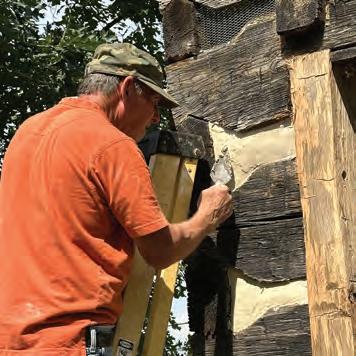
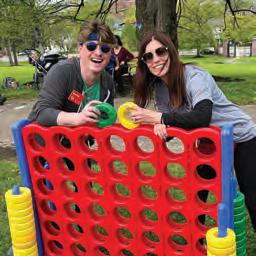

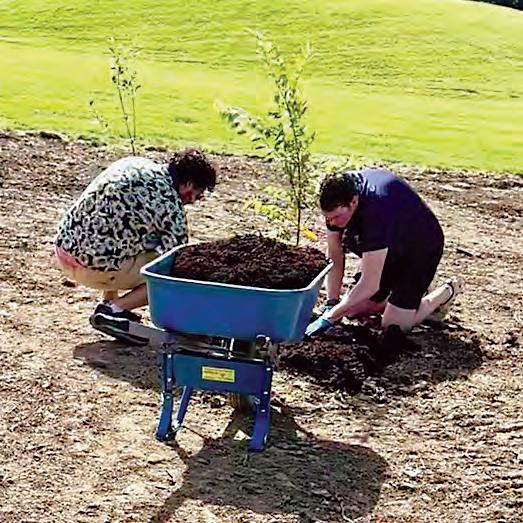
By Mardi Isler, SHUC’s Immediate Past President

AFTER SIX YEARS I HAVE STEPPED DOWN AS SHUC’S PRESIDENT. The coalition’s mission was a passion for me when I started my tenure, and it remains so today. But leadership is also knowing when it’s time to retire—to provide opportunities for others who’ll bring new energy, be creative, and challenge long standing routines.
Looking back at these six years, I’m very proud of all that SHUC has accomplished while being completely aware that successes are a team effort. It’s impossible to recognize here the multitude of volunteers who support our efforts. Just one example of committed volunteers who continue to amaze me is the Litter Patrol participants. They manage to make Forbes and Murray look presentable whenever events bring visitors to the area. I’m also amazed by the pro bono assistance we receive from so many professional disciplines. SHUC’s activities are many faceted, and we therefore need expertise in so many fields. The cooperation we have from institutions, businesses, and other non-profits is awesome.
I’ve always had a strong belief that urban design, the aesthetics of public spaces, and celebratory events in a community make our connections with neighbors easier and more pleasant and contribute to our general happiness. SHUC has received grants from government and private foundations to bring improvements to the business district, provide respite areas for residents and visitors, plant trees for shoppers, and bring parades, music, and festivities to our streets in concert with partnering organizations.
I’ve long considered myself to be a cheerleader for all that’s good and unique about Squirrel Hill. I usually start by talking up the connections we have here. It’s a place where we know our neighbors, we know our police, and the Fire Station is a welcoming place to visit with children and grandchildren. There are merchants who will deliver to us in times of need. We have a varied restaurant scene where, inevitably, we’ll run into someone we know—maybe even a visitor from another neighborhood. We have early walkers who take our Sunday newspaper to the porch in bad weather. We live on a street where friends and neighbors drive and walk by every day, sometimes stopping to chat. We’re connected. I can honestly say that in small and large ways Squirrel Hill gives back to me every day!
I can honestly say that in small and large ways Squirrel Hill gives back to me every day!
Many have asked what I’ll do with my extra time when I’m no longer serving as President. I’ll still be on SHUC’s Board, the Treasure Committee, and the Tree Committee. Trees on Forbes were actually my first effort volunteering with SHUC and are still a priority for me. I can’t imagine a Squirrel Hill without substantial shade. There is new talent on the Tree Committee that’s infusing technology into the work, analyzing the tree canopy data provided by Tree Pittsburgh, and showing us what 15 years of growth looks like on the trees we’ve planted. Treelined


streets and restoring trees in our parks will enhance our public green spaces, which research tells us has positive effects on health and social relations. As one of my favorite quotes says, “the best time to plant a tree is 20 years ago, the second-best time is now!”
Personally, I have a lot to keep me busy. I have an unfinished project room on my third floor: a room of family tree archives going back to 1583 that needs to be organized. I have Christmas stockings to knit, canning to do, and my favorite, spending time with my grandchildren, cooking for them and my nieces and their husbands, and having corn fests for neighbors and friends.
And I have so many thank yous to write and appreciation to express to all who have supported SHUC with recurring and generous contributions of time and money—this is what allowed our team to do what we have achieved!
I’ll still be here, where I’ve happily been for 40 years and counting—you may remember what I’ve always said: “I hope to die here with my boots on! Just not anytime soon!”


As of the printing of this issue, Dalia Belinkoff is the President of the Squirrel Hill Urban Coalition. Thank you, Dalia, for stepping into this role and continuing to serve Squirrel Hill!
Look for her letter in the Fall/Winter issue of Squirrel Hill Magazine. Until then, you can reach her at president@shuc.org.

THIS SUMMER, VISITORS TO SCHENLEY PARK CAN SEE SOMETHING THEY HAVEN’T SEEN IN A LONG TIME: A FULLY RESTORED NEILL LOG HOUSE. Thanks to a multi-year restoration effort led by Friends of Neill Log House with support from the Squirrel Hill Urban Coalition, this remnant of Pittsburgh’s early history is now ready for its next stage as a historical site open to the public. Stay tuned for information on how to visit it.
Various skilled specialists worked to conduct the restoration. By design, much of their work is hard to see in the restored house. To pull back the curtain on their talents and labor, we offer these glimpses into the restoration process.
Text by Melissa Eppihimer.
Photos courtesy of Tony Indovina, Mardi Isler, and Village Restorations & Consulting, Inc.

Before the reconstruction began, the Neill Log House (NLH) was being propped up by exterior braces, and its shingled roof was covered by black tarp to keep the rain out. (And these were only the most visible problems!) Clearly, the structure, which had last been rebuilt in 1969, needed extensive repairs if it was to remain a testament to the architecture and domestic life of rural Pittsburgh in the late 18th century.
Constructed by Robert Neill on his farm east of Pittsburgh
Donated to the City by Mary Schenley in her gift of the land that became Schenley Park
Studied by Charles M. Stotz in his book The Early Architecture of Western Pennsylvania
Reconstructed by Pittsburgh History & Landmarks Foundation after it collapsed in 1967
Friends of Neill Log House forms to support current restoration project and future educational uses of the house

The original builders of the NLH constructed it using logs they felled by hand in the surrounding forests. Among the local species was the white oak, a tall hardwood tree that provided suitable building materials. The white oak still populates forested pockets of Schenley Park like Panther Hollow, but the white oak logs used in the recent reconstruction of the NLH were acquired in a more modern fashion— they were ordered from a logger.
After the logs arrived at Village Restorations & Consulting’s work yard in Frankstown, Blair County, log house specialist Roland Cadle and his team set about prepping them for use in the NLH. The process, called hewing, transformed the circular logs into rectilinear planks using axes.


Next, Cadle and company transported the hewn logs nearly 100 miles to Schenley Park, travelling west over the Allegheny mountains just like Pittsburgh’s early settlers. Unlike the settlers, the logs—the longest of which measured 25 ft!—rolled along Route 22 on a flatbed trailer pulled by a pick-up truck. On site, they were offloaded in anticipation of being used to replace rotten logs in the Neill Log House.
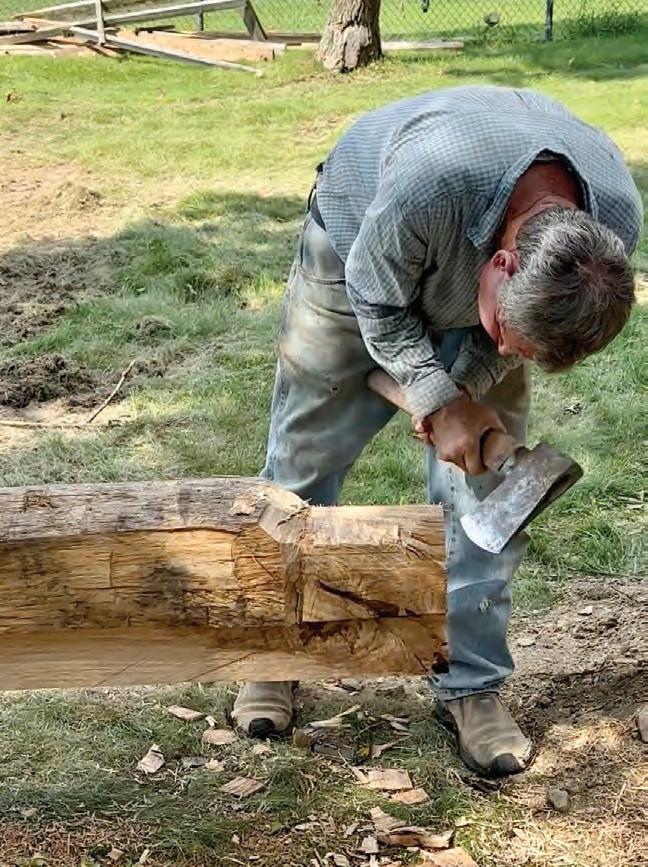
Once the house was shorn up and all the replacement logs were in place, the next step was to prepare the NLH for new chinking. Chinking is the material that fills in the gaps between the logs; if there’s no chinking, then the sun’s rays, as seen here, and all sorts of elements will penetrate the house. In addition to weatherizing the interior of the house, chinking adds stability to the walls. The eighteenth-century chinking would have been all natural, primarily clay applied to small stones. Although the modern chinking is synthetic to enhance its effectiveness and the durability of the restoration, it is finished to a color that mimics the historic appearance of the log house.
The new logs were needed because many of the logs installed during the 1969 reconstruction were rotten. When preparing replacement logs, Roland Cadle employs traditional tools and techniques whenever possible, and his log house labors are rooted in an intimate knowledge of historical building practices.
In his lifetime Cadle has restored, dismantled, moved, and re-erected at least 200 log houses. There was no manual that Cadle could consult to learn how to restore a log house, no class to take. Instead, he learned by looking closely at existing structures and reading manuals about cutting stone and hewing logs written back when log structures were the primary architectural form in Western Pennsylvania. “I just wish I would have been around back then, because I could have learned something,” said Cadle.


Together with the chimney, the fireplace is one of the few original elements from the 18th-century structure still standing today. Unusually, it has two hearths, the larger one for cooking in the main room, and the smaller one for warming a second, rear room. While today the interior is maintained as one space, it was originally divided in two. In this photo, a wooden panel suggests where the separating wall once stood. One can also see that the fireplace was parged, meaning its surfaces were smoothed by a cement-like mixture, during the restoration. While a stereotypical hearth has a metal crane that could swing in and out of the fire, the main NLH fireplace had a wooden lug-pole stretching across the fireplace where pots could hang. According to Roland Cadle, the original attachment points for this pole were revealed during the restoration exactly where they were expected to be. Roland will be reinstalling hearth hardware that was removed for restoration work.

One of the real surprises of the restoration work was the result of the dendrochronology tests conducted on the log that forms the lintel of the fireplace. Before the physical restoration process began, Nick Wiesenberg of the College of Wooster Tree Ring Lab used a small borer to take a core sample from this log. Then, by comparing the wood sample’s ring pattern to an established sequence of tree growth rings from the region, the lab determined that this log was cut in 1795. An old door frame stored in the loft was found to have the same sequence of growth rings and is now, like the hearth lintel, confirmed to be original to the log house.
This date is somewhat later than what historians previously thought was the year of the house’s construction. Now, historians are rethinking the length of time that the Neill family would have spent in the house before selling it and the surrounding land in 1795, as the historical record indicates they did.
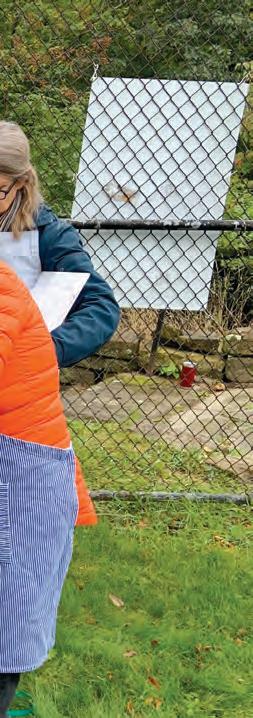
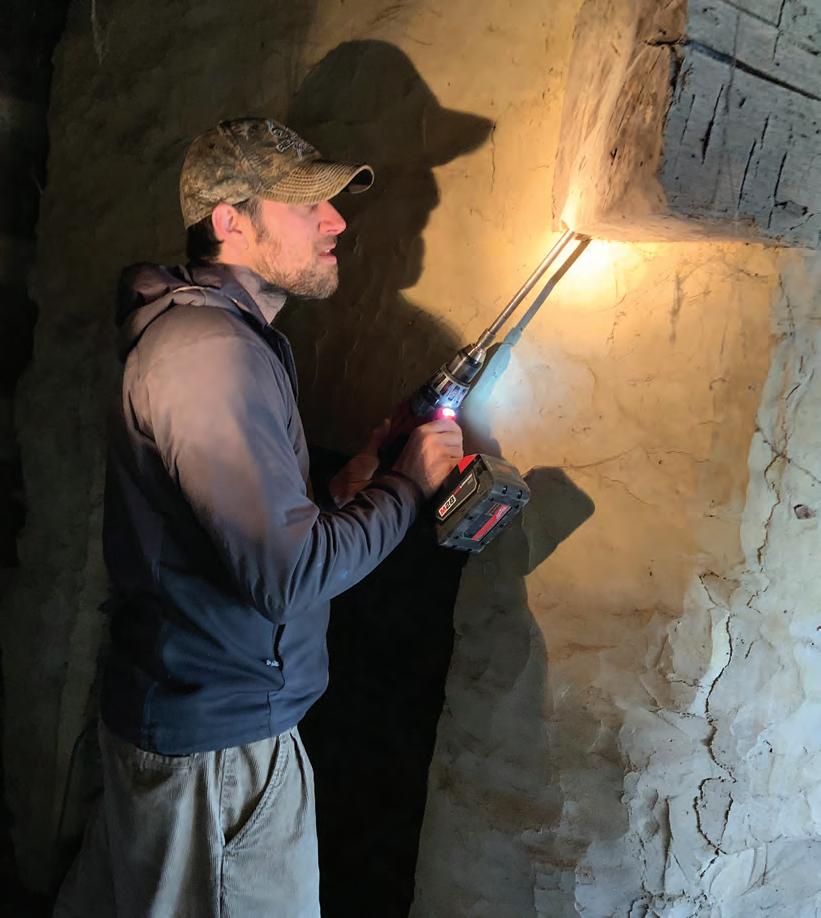
A house is a not a home without its people—and often their possessions. In 1969, the Junior League of Pittsburgh helped assemble a collection of historical artifacts for the NLH. None was original to the house, though they were all original to the 18th century, and not all would have been affordable to the house’s early inhabitants. Nevertheless, as part of the NLH’s modern heritage and as historical artifacts themselves, these objects also deserved attention during the current restoration.
Object Conservators Patty West and Rhonda Wozniak came to the site to assess the condition of objects like this wooden tool thought to be a type of jigsaw, looking for evidence of damage due to animal pests and environmental conditions. Their assessments are currently being used to determine which objects will be restored and displayed in the NLH.

One of the final steps was to add a new roof. Made of cedar shakes (which are hand cut rather than sawed like shingles), the roof gives a rustic appearance to the building in addition to serving a practical function. From foundation to roof, the Neill Log House is ready for the next phase of its already long life. “It was a major overhaul, and right now, if there’s upkeep it should last another 100 years,” said Roland Cadle.
It might not look like much, but this landscape in progress reveals essential upgrades to the NLH site needed before it could function as a historical site open to the public. The white electrical wire at the bottom edge of the wall hints at the only modern amenity required. The grading of the soil around the house got rid of trenching that was necessitated by foundation work, added a French Drain on three sides, and contoured the ground to further improve drainage. The limestone steps at the left soon became part of a landscape design dotted with fruit trees donated and planted by Tree Pittsburgh. The steps were salvaged from the path that formerly led from E Circuit Road up to the house.



By Jim Rogal
THERE’S A MIGHTY GOOD CHANCE THAT IF YOU LIVE, EAT, OR SHOP IN THE EAST END OF PITTSBURGH, YOU HAVE A CONNECTION WITH WALNUT CAPITAL, ALTHOUGH YOU MIGHT NOT KNOW HOW. Perhaps you’ve seen the Walnut Capital signs around Squirrel Hill or Shadyside or East Liberty, the most prominent of which is at Bakery Square on Penn Avenue.
Despite the public profile they maintain, it’s fair to say that most people don’t know who they are and what they do, because so much of it is just part and parcel of everyday life in Squirrel Hill and the East End.
“They” are Todd Reidbord and Gregg Perelman, and what these long-time business partners do is own residential apartment buildings and varied commercial properties all over the East End. Currently, Walnut Capital manages some 2,500 apartments—in Squirrel Hill, Beacon Commons, Forbes Terrace, Hobart Court, Walnut on Forbes, Walnut Towers at Frick Park, and Walnut on Wightman, to name a few. Their commercial properties include most of the establishments on Walnut Street in Shadyside, multiple retail and restaurant properties in Squirrel Hill, and the aforementioned Bakery Square.
But they will tell you that whether you examine any of their rental properties, or shop at any of the stores, or eat at any of the restaurants that lease space from Walnut Capital, Reidbord and Perelman have been very successful by weaving one common thread through

everything—“Customer service,” said Perelman. “It’s what we base our business on.”
“All real estate is local,” said Reidbord, “and we operate that way”—“So we were able to create a new market for town house living in Squirrel Hill,” said Perelman— “We felt like we saw what was happening in this area,” said Reidbord.
More on all of that later, but these guys are so connected that they finish each other’s sentences and provide each other’s background information. It’s clear that their close partnership exists in large part because they share an underlying approach to their business.
“Anybody can rent out an apartment. What we rent is the people,” said Reidbord, emphasizing their staff’s focus on customer service. “We strive for quality, always; in our commercial projects as well.”
So how did two native Pittsburghers, neither originally from the East End, end up such good friends and partners? The answer is simple: They were both
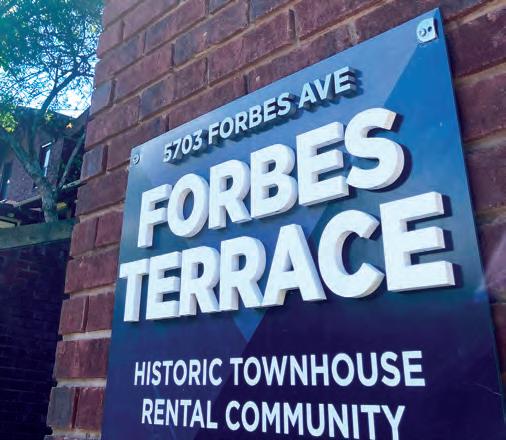
horseback riding counselors at the Emma Kaufman summer camp in the late ‘70s. Wait. What? You read it right—they taught horseback riding together. Each had done some riding growing up, so by pure coincidence that’s where they found each other—on horseback.
Reidbord went on to earn a law degree and to practice here, while Perelman took over his father’s drug store in Churchill and went on to develop a national pharmaceutical distribution company. They stayed friends, and in the early 1980s they decided to throw in together when they recognized a real estate opportunity in Squirrel Hill.
“Everybody kind of looks at 1983 as the low point for Pittsburgh,” said Reidbord. “The steel industry was collapsing, and the city lost almost half of its population. That’s when we started.”
“We bought some Squirrel Hill fixer-uppers, and we started tinkering,” said Perelman. “We found some dilapidated properties that could be improved.”
“We kept seeing the changing demographics in the area,” said Reidbord. “The ‘eds and meds’ were growing here (education and medicine), and people were coming in from all over the country and the world.”
Squirrel Hill had “good bones,” he continued, “good housing stock, universities, and hospitals. We made a conscious effort to work in Squirrel Hill. Diversity was growing, and we knew that this was a stable community, a good place for young families and kids and dogs. And the eds and meds weren’t going anywhere.”
In the mid-’80s they left their respective careers and went into the real estate business full time, focusing on residential properties. In 1998 they relocated to Walnut Street—thus, Walnut Capital—and began their moves into commercial properties. Ten years later, the old Nabisco plant on Penn Ave. closed, and the opportunity emerged to redevelop the entire site. Despite the risk, the cost, the breadth of the project, and the time it would take, Reidbord and Perelman took the leap. Over the next 15plus years, they executed an incredible transformation of the site into what is now Bakery Square.
These years also saw them add some of Squirrel Hill’s oldest housing communities to their portfolio. Walnut Capital chose to renovate, rather than tear down, the historic townhomes of Beacon Gardens, Forbes Terrace, and Walnut on Wightman, which date to the early 20th century. The preservation of these buildings helped maintain Squirrel Hill’s distinctive character.
On any given day you can find Perelman prowling Bakery Square in blue jeans and a button-down shirt, with his phone glued to his ear. He and Reidbord are decidedly hands-on managers, and they aren’t going anywhere any time soon.
“We aren’t thinking about retiring,“ Reidbord said. “We’d be doing the same thing anyway. It’s what we do.” Moreover, they’re happy with and proud of what they’ve accomplished, much of it quietly, behind the scenes, in the resurgence of the East End over the past several decades.
“People always yearn for the good old days, but look at Squirrel Hill now,” Reidbord said. “There is so much diversity, culturally mixed retail and restaurants. We think these days are pretty darned good.”

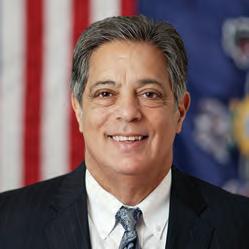
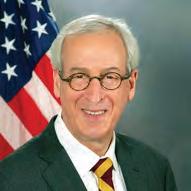
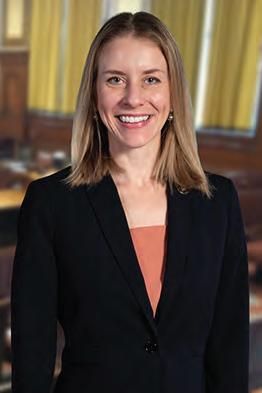
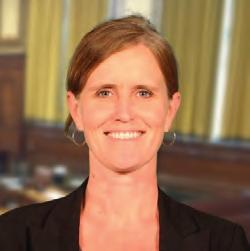
State and City Council Corner shares reports submitted by the elected members of Pittsburgh City Council and the Pennsylvania Legislature that represent Squirrel Hill.
Behind the scenes, Senator Costa is fighting for every Pennsylvanian, taking meetings with fellow legislators, Governor Shapiro, activists, agencies, and more to advance the priorities of the Senate Democratic Caucus.
In May, CeaseFirePA and Squirrel Hill Stands Against Gun Violence came to Harrisburg to call on the Senate GOP to run bills that will keep firearms out of the hands of bad actors. Prior to a rally, a group of activists, family members, and faith leaders met privately with Senator Costa to share personal stories about the trauma, heartbreak, and sorrow that followed every gun death. From suicides to accidental shootings to interpersonal violence and beyond, Senator Costa brings these stories with him as he negotiates for safe communities for all.
In the housing space, Sen. Costa works closely with Pennsylvania Housing Finance Agency, ACTION-Housing, and the PA Human Relations Commission to deliver safe, affordable housing for every Pennsylvanian.
Currently, the Pennsylvania Department of Health lacks the authority to provide the necessary oversight to ensure medical marijuana products are labeled accurately and meet product standards.
As the Chair of the Health Committee, State Rep. Dan Frankel held several hearings on marijuana, where testifiers noted that a lack of state oversight leaves our medical marijuana patients vulnerable to exposure to heavy metals, products contaminated by mold, and inaccurate measurements of THC levels.
In the House, Rep. Frankel introduced and passed HB2208, legislation to addresses these issues by requiring independent labs to submit their standard operating procedures to the Health Department and conduct investigations, compliance testing, and audits to ensure results are accurately reported. This increased oversight will ensure that the medical marijuana consumed by Pennsylvanians is accurately labeled with THC measurements and safe for consumption.
Rep. Frankel is working to get these protections in place now, prior to a full decriminalization of cannabis. That way, consumers of a future adult-use market would also enjoy these protections and assurances that they know what they are getting when they buy cannabis products.
City Council worked doggedly behind the scenes for several months in order to adopt a new tax abatement program to revitalize our Downtown. By ensuring that Downtown thrives, Pittsburgh will continue to generate the resources needed to keep residents safe, provide housing, promote economic opportunity, and create a greener, cleaner environment. This approach benefits all neighborhoods, from Squirrel Hill to Beechview to Brighton Heights.
Council Members engaged with the Mayor’s administration, labor leaders, developers, and community stakeholders to ensure the program will address the diverse needs of our Downtown community. After a thorough public process and the adoption of several crucial amendments, Council is pleased to have passed a resolution authorizing this tax abatement program.
Thanks to this diligence, we’ll stabilize our Downtown real estate market and spark the types of renovations that will create the thriving, sustainable, and vibrant Golden Triangle of the future.
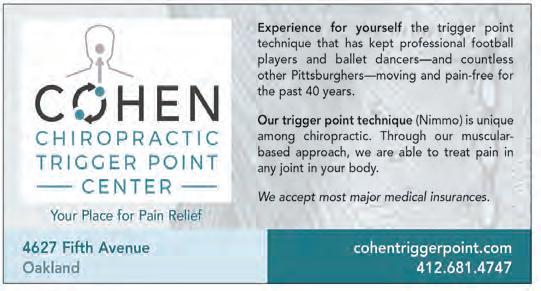
This spring, Councilmember Warwick introduced a resolution making Pittsburgh a Vision Zero city, formally adopting the goal of reducing traffic fatalities and injuries in the city to zero.
Vision Zero is a strategy spreading to municipalities across the United States which provides a framework for making our streets safer. It prioritizes safe, accessible, healthy, and equitable mobility for everyone through a combination of engineering, education, and enforcement.
Now that the resolution has passed, the Department of Mobility and Infrastructure has established a Vision Zero working group comprised of representatives from every City department. The working group will make recommendations on how to invest resources and change policies to integrate Vision Zero into every part of the city government’s work, from data collection to traffic enforcement to street maintenance and beyond.
It will take infrastructure changes, behavioral changes, and investment, but we can make our streets safe for every road user.



Those three words capture some of Falk Laboratory School’s most important ideas about learning and community.
To wonder is to engage with the world. To care is to show concern for others. And to act is to put a plan into action, whether that means answering a question or solving a problem.
Wonder, care, and act are examples of the progressive educational principles that guide Falk toward a child-centered approach to learning that focuses on each student’s social, emotional, and academic needs.

At Falk, we also emphasize collaboration, intrinsic motivation, and active learning. Our inquiry-based instructional model requires children to reflect upon and take ownership of their own learning. As a community, we also are guided by the thoughts and intentions found within the faculty-created booklet “Wishes for Our Children.”
To learn more about Falk and our “Wishes for Our Children,” visit falkschool.pitt.edu.
By Kimberly Kweder
ARE ALWAYS HAPPENING IN SQUIRREL HILL. BUT HOW? Who’s hard at work, and how do they do it? Here are some examples of how things get done in the neighborhood.
HOW DOES THE ALLDERDICE MARCHING BAND PREPARE ITS DRILL?
The Allderdice Marching Band has a two-week long band camp at the end of July where the 30-35 students get to know each other and learn the music and movements that make up the drill. During the school year, they practice twice a week, with the drum line working a little bit more.
Brian Lee, the Marching Band Director who’s heading into his 20th year, said the summer band camp usually meets six hours a day for one week at Allderdice, and then all day during one week at PennWest California, where they head to the dormitories at night to sleep. The PennWest cafeteria is available to the students for food and beverages.
As for the drill, it starts with Lee and George Edwards, the drumline instructor and an Allderdice alum (Class of 2007), listening to new and old songs before writing out the drill. About 8 to 10 songs are eventually selected. The drill is based on measures and counts and what makes sense visually. “A lot of it develops organically during the band camp, and we work with students to see what works with shapes they form,” he said. He asks students what they think is cool and

fun about different variations and uses easy terms to help illustrate their steps. Common terms are “boxes, triangles, and squiggles.”
Most of the marches they do are noncompetitive in nature. They play at football games and for the general public at 5K walks, special causes, and holiday events including Light Up Night.
“We get around the town a lot!” Lee said.
The Pittsburgh Center for Arts and Media (PCAM) is a non-profit community arts organization that offers arts education programs and contemporary art exhibitions. The center’s Education and Communications Director Emily Stedge plans all the classes term after term. Last year, the PCAM ran 265 classes, and this year they are on track to run 350 classes, according to Stedge.
Stedge says that she works with local artists who have teaching experience and their own practice. She takes an instructor-based approach to developing the classes but also reaches out to the students to understand the demand; the students pitch ideas to instructors and work on proposing class courses. Stedge reviews schedules and waitlists from past terms, all to ensure courses meet the needs and wants of the existing arts community. There are about 30-40 instructors working at the center, varying in number from season to season.
When thinking of the schedule, Stedge said she really wants to be able to maximize the space. They have ten studios at the PCAM, and they try to have at least one class per studio each day. Stedge also has a registration team to help make the classes happen.

HOW DO BOOKS GET TO SQUIRREL HILL’S CARNEGIE LIBRARY
The Squirrel Hill library has the second busiest circulation in the Carnegie Library of Pittsburgh (CLP) system, according to Library Services Manager Jody Bell. As with all local library branches in CLP, the branch relies on the Library Support Center in the West End for the ordering and distribution of all circulating materials. The Library Support Center uses a multitude of professional resources to build CLP’s collections. The West End facility also serves as a distribution center for materials sorting and distribution to all public libraries in Allegheny County. Although the Squirrel Hill Library doesn’t choose its own items for the collection, the library staff follow industry trends and work with the Library Support Center to choose items that are relevant to the Squirrel Hill community.
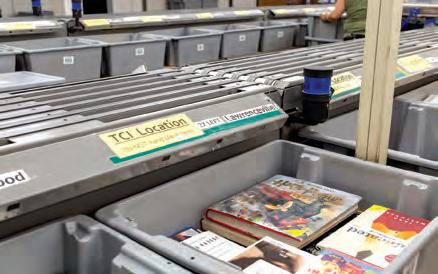
Over 200 businesses are in Squirrel Hill, and the nonprofit Uncover Squirrel Hill works hard to boost local business development, build community among merchants and customers, and hold special events.
Uncover Squirrel Hill’s Membership and Event Coordinator, Robyn Crawley, said that a small team of two part-time employees, including herself, are focused on the goal of supporting the neighborhood by connecting businesses with resources, and by bringing more business to the neighborhood. It starts with frequent communication with the merchants, she said.

The Jewish Community Center of Greater Pittsburgh’s Big Night, which is traditionally held in March, transforms the JCC in Squirrel Hill around a specific theme with food, a raffle, a silent auction, music, and entertainment—all in celebration of and as a thank you to those who support the JCC.

“One of my favorite aspects of my job is the relationships I’ve built with our merchants. I communicate often with them via email and by visiting in person to say hello. I think of myself as an advocate for our businesses and want to connect them with resources to help them succeed and grow,” she said.
“We as an organization take the theme really seriously,” said Melissa Hiller, JCC Community Engagement and Development Officer. “We try to match the current pulse of Pittsburgh’s Jewish Community and choose a theme that is fun and will bring people together.”
This year’s theme was “Shining a Light on Community”; the event honored JCC’s former President and CEO Brian Schreiber and was chaired by Lori and Jimmy Ruttenberg, Nancy and Woody Ostrow, and Dory and David Levine.
Big Night is a time for the community to gather together and help raise the necessary funds for the JCC to continue providing programs, meet community needs, and ensure cost is never a barrier, according to Fara Marcus, Chief Development and Marketing Officer at the JCC. The main goals are to raise annual operating funds and support the JCC’s scholarship program. This year, about $2.5 million in scholarship and financial assistance were anonymously provided to those in need.
Preparing for Big Night is a yearlong effort. A development and marketing team—called the Big Night
Communication is key at Uncover Squirrel Hill, including emailing and talking directly to merchants to find out what extent they want to get involved in events. They also take care of details such as ticket sales, graphic design, and providing maps for events like the Night Market and Wine Walk.
Uncover Squirrel Hill sends out a weekly newsletter to merchants with information on upcoming events, recaps of past events, grants, local city laws, permits, and updates on seminars that take place throughout the city at local universities and other non-profit organizations like Sustainable Pittsburgh.
Monthly merchant meetings are also held at the Squirrel Hill library to discuss anything going on with their business, good or bad, and provide feedback. A quarterly “meet-and-mingle” is held at a merchant’s business.
team—focuses on everything from planning and fundraising to day-of event activities. The week before Big Night, vendors such as Common Plea, Mosaic Linens, Hens and Chicks, and PRISM begin setting up their equipment and supplies. They do this even as the JCC maintains its regular programming, keeping the gym open for use and welcoming senior adults to their regular lunches. By the start of Big Night on Saturday night, the JCC’s familiar spaces are unrecognizable. Despite the colossal transformation, visitors to the JCC the next morning will have a hard time finding signs that the grandest party of the year occurred just the night before.
According to Hiller, there’s always collective agreement at the end of each Big Night that “This was the best Big Night ever!” and that realization motivates the team to start all over for next year.
“The purpose of JCC is to meet our community needs and make our facilities accessible and welcoming to everyone,” said Marcus. Big Night is an important part of making that possible.
Like jewels, Gaby et Jules’ French desserts first attract attention for their exquisite appearance. However, the secrets to the success of these pâtisseries, as they are called in French, are their dazzling flavors.

David Piquard, Gaby et Jules’ Pastry Chef, finds inspiration for his flavors in the natural world. “Mother nature gives you everything,” he said.
Whether walking through a forest or visiting a farmer’s market, Piquard is often attracted to the aroma of an ingredient first. Then, keeping the characteristics of that flavor in mind, he considers what might complement it. Something smooth and delicate like peach needs a more subtle companion, whereas pineapple, which is strong and acidic, must be balanced by something able to stand up to its potency.
Once he has a flavor combination in mind, Piquard turns to the design of the pastry, but the opposite path is also possible. He or one of the other chefs may start with a design and then develop flavors that suit its theme or structure. After rounds of testing and adaptations, the new product is ready to be unveiled. The entire process could be quick, if all goes well, or it could take several weeks to achieve the perfect outcome.
The pastries at Gaby et Jules maximize flavor by having less sugar than American desserts and by using real, fresh ingredients. Even though inflation has increased costs, Piquard remains committed to sourcing quality ingredients because of their impact on flavor. “We want people to taste the flavor of real raspberries, real chocolate,” Piquard said.

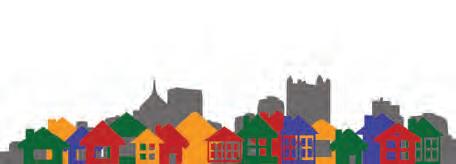

Meccha Matcha
Squirrel Hill has long been home to coffee shops that raise our energy level and ice cream parlors that cool us down. Now, Meccha Matcha (2000 Murray Avenue) can do both at the same time with its matcha desserts and beverages.
Matcha is the powdered form of specially grown green tea leaves. At Meccha Matcha, it’s blended into scoops of ice cream, swirls of soft serve, or bowls of shaved ice. Alternatively, you can order your matcha hot, in tea or latte form. Whichever you pick, you get to decide just how strongly flavored—and caffeinated—your matcha will be. Level 1 is best suited for anyone trying matcha for the first time. It has about the same amount of caffeine as a cup of coffee. Level 3, on the other hand, has three times that amount and a deep matcha flavor.
Once a year, on the anniversary of the company’s founding, Meccha Matcha offers Level 5 ice cream for the matcha connoisseur. But be warned—it’s not just the flavor that’s enhanced. The caffeine level rises too.
A family-owned business, Meccha Matcha has joined members of its family in Texas, California, and now, for their third location, Pittsburgh. Their mission is to show customers what great matcha tastes like.
“Most who think they don’t like it have had a bad experience,” said co-owner Sitavy Thorng.
To counter this impression, Meccha Matcha insists on quality ingredients, with 100% pure matcha sourced from Japan. Most items are made in house daily, including their soft serve and handmade mochi balls. Both are key ingredients in the many-layered Meccha 8 Parfait, which also includes matcha cake, matcha jelly, strawberry sauce, waffle crackers, red bean, and whipped cream. Meccha Matcha also prepares espresso drinks, specialty teas, and caffeine-free options.

This fall, Carriage House Children’s Center celebrates fifty years of providing quality early childhood education to local families. Natalie Kaplan, Carriage House’s visionary founder, recognized in 1974 that mothers needed a nurturing and educational environment for their children while they worked or pursued an education. Since then, the needs of families and their children have only grown, and Carriage House has kept pace, moving from a structure on Chatham’s campus to its own “campus” in the Wightman building, where a suite of classrooms, a large gym, and expansive outdoor play spaces give children plenty of space to thrive.
A lot has changed—for the better!—over Carriage House’s fifty years in operation, including the introduction of accreditation and safety standards and an expansion of Early Childhood Education degree opportunities for a staff made up of childcare professionals. Nevertheless, Sharon Amick, Executive Director of Carriage House, emphasizes that the secret to its success remains the same: the relationships they build with families. “Building strong relationships with families is essential because we are entrusted with their most precious gift—their children,” said Amick.
The importance of these relationships became especially apparent during the COVID-19 pandemic as work schedules became more flexible and family needs changed. Carriage House is also keenly aware of other ongoing challenges in early childhood education, like the difficulty of attracting teachers to this field. Most fundamentally, it recognizes that childcare is an urgent concern locally and nationally that needs support from the community, businesses, and governments.
On September 14, supporters of Carriage House will gather at the Wightman Building for a fundraiser honoring the center’s fifty years of operation. Guests will enjoy a jazz band, drinks and hors d’oeuvres, and a silent auction. (For more information and to purchase tickets, visit https://givebutter.com/bduq2t). The funds raised will contribute to the reimagining of the Center’s outdoor play spaces to include more educational and interactive elements, sensory learning, and responsible environmental design.
This outdoor classroom is a visible reminder of Carriage House’s connection to the Squirrel Hill neighborhood. “Being tucked in among the family homes and the park, we feel a part of the living community,” said Amick, noting that many families walk, bike, or scooter to school. For those families, as well as for the places where the adults in those families work or go to school, Carriage House is indeed an invaluable part of the community.

In June, a new work of art debuted inside the Frick Environmental Center. The Healing With Nature Mosaic results from a collaboration between individuals who came together to promote healing and resilience while reflecting upon personal loss and grief.

Working over several sessions this past spring, artist Laura Jean McLaughlin helped the participants construct the wall mosaic with a mirrored teardrop at its center. The concentric bands circling the teardrop are made up of glass, stone, and ceramic fragments mixed with recognizable items like figurines and chess pieces. Some materials come from the Tree of Life Synagogue, while others hold personal significance to the participants. Still others derive from when the group turned to nature as a place of healing; these include clay pieces marked with the impressions of branches, rocks, and other natural elements.
The project was supported by many local organizations, including the 10.27 Healing Partnership, Jewish Family and Community Services, and Pittsburgh Center for Arts and Media in Squirrel Hill. It can be viewed during the Frick Environmental Center’s open hours, 10 am to 4 pm daily.

Squirrel Hill and SHUC thank Officer Victoria Butch and Zane, Zone 4’s comfort dog, who both recently retired from the Pittsburgh Police. Officer Butch has served our community with kindness, devotion, and extra care. Although she may be most recognized as Zane’s human handler, Butch served many roles in the Police Department and the City of Pittsburgh. Before becoming a police officer, she worked for the Parks and Recreation department. Fortunately for our community, Butch isn’t going far and is starting a new role as Head of Security at the JCC. When you see her, please thank her for her dedication and service to our community.




By Melissa Eppihimer
This is the third entry in a series highlighting the work of SHUC committees and their members. We focused on the Litter Patrol in the Spring 2022 issue and the BicyclePedestrian Committee in the Spring 2023 issue. This time, we turn our attention to the Tree Committee.
“MOST PEOPLE WILL SAY THEY LOVE TREES,” SAYS GARY CROUTH, A LONGTIME MEMBER OF SHUC’S TREE COMMITTEE. THE TREE COMMITTEE LOVES TREES FOR SURE. Its members also love the positive impact that trees have on an urban neighborhood. Among their benefits, city trees provide
• Shade, which brings relief for pedestrians and bikers and lowers energy costs associated with cooling buildings and parked cars
• Reduced stormwater runoff and pollutants in the air and water

• Habitats for birds and other wildlife
• Beauty and character, which increase property values
Yet, the coexistence of trees and urban life is not a given. Many cities in America struggle to preserve existing trees and grow what’s called the urban canopy, the array of trees distributed among the streets. SHUC’s Tree Committee works to keep Squirrel Hill a leafy oasis in the City of Pittsburgh, nestled between the green “lungs” of Frick Park and Schenley Park.
In late 2007, Squirrel Hill residents started to find that the tall and majestic trees that lined their streets in the morning had disappeared by the evening. They were being cut down by the City of Pittsburgh as part of a city-wide street tree management initiative. Many neighbors felt that they were not given fair notice of or explanation for the tree removals.
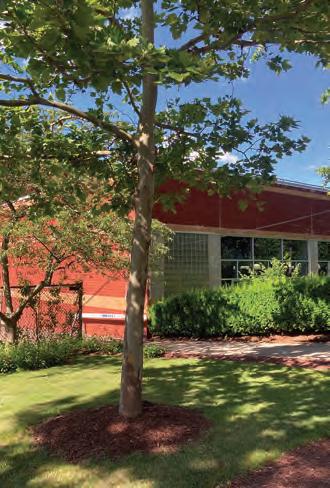
“When the community saw the trees suddenly gone at the end of a workday, that galvanized the community to pay more attention to our street trees,” said Crowth.
SHUC’s Tree Committee facilitated conversations between the City and the Squirrel Hill community. At a public meeting, the City explained that the unhealthy trees were becoming a danger to people walking or driving beneath them. While the trees’ removal could not be avoided, it was clear that better communication was necessary.
The Tree Committee began meeting monthly to address the issue. One outcome of their efforts was a requirement for the City to notify the public four weeks before any tree removal. This is why posters identifying why a particular “Gentle Giant” is slated for removal now hang from street trees before any action is taken. Residents can appeal pending tree removals, and City policy is to plant a new tree where possible when an old tree is cut down.
It’s difficult to see a beloved tree cut down. Sometimes, it’s even difficult to see why a tree must be cut down. But disease and pests can take a toll on a tree in ways that are invisible to most observers; some impacts can only be seen by boring into the tree to assess its interior. To keep us all safe, these trees must be removed.
When a tree is removed, the Tree Committee takes note and factors it into plans for new trees to be planted in the neighborhood.
Compared to many Pittsburgh neighborhoods, Squirrel Hill is quite fortunate in the amount of land shaded by the tree canopy: 40.5% in Squirrel Hill North and 50.8% in Squirrel Hill South, as of 2020. For Squirrel Hill South, the number represents growth over the last five years, but zoom in on a micro scale, and you’ll find that the trees maturing in the Summerset at Frick Park development are masking a

decline in tree cover in other parts of the area, where many older trees have reached the end of their natural lifespans. Likewise, in Squirrel Hill North, the loss of such Gentle Giants means that the tree canopy decreased over the last decade.
Summerset’s successful tree growth demonstrates a proverb often cited by Mardi Isler, SHUC’s recent President and a longtime advocate for Squirrel Hill’s trees: “The best time to plant a tree was 20 years ago; the second-best time is now.” While it can’t go back in time, the Tree Committee is trying to counter the anticipated loss of Squirrel Hill’s remaining Gentle Giants by planting new trees.
The Tree Committee begins the process by analyzing which streets are in greatest need of trees. This involves both digital and analog labor. Digitally, the team uses data mapped in a GIS system to measure the tree
canopy block by block and to judge how it’s changed year to year. They also review old Google Street View images to visualize what’s been lost by tree removal and what’s been gained through new plantings.
In the analog realm, Tree Committee members hit the pavement, walking through the neighborhood to scout out locations for new trees. Scott Bluman and Jeremy Kazzaz spent time this spring along Beechwood Boulevard, which has many trees that will soon need to be replaced. While out and about, Bluman and Kazzaz knocked on doors to talk to neighbors about the benefits of adding a street tree on their property.
People often express concern that a new tree’s roots will damage their sidewalk or send small roots into their sewer lines, as Pittsburgh street trees have done in the past. However, Bluman and Kazzaz point out that the trees planted in
decades past were chosen without regard for their suitability for this specific environment. That’s why they grew into power lines and broke apart sidewalks. Moreover, they were often not native species.
“Those trees are being replaced by a far more bio-diverse set of trees that are better suited for the urban environment,” said Kazzaz.
The rewards of the new trees greatly outweigh the costs. And for residents, the initial financial costs of acquiring a new tree are quite minimal.
SHUC’s Tree Committee partners with several local and regional organizations to share the cost and labor of planting and maintaining new street trees.
Twice a year, after considering the needs of the neighborhood, the Tree Committee (through SHUC) submits a grant proposal to TreeVitalize, a program of the Pennsylvania Department of Conservation and Natural Resources. If the request is approved, TreeVitalize funds and facilitates the delivery of new street trees for the neighborhood. This process has resulted in 267 trees planted across Squirrel Hill since 2007.
With assistance from City of Pittsburgh City Forester, Lisa Ceoffe, additional trees are provided for special projects and replacements. If a new tree is replacing a tree cut down by the City, the City will grind out the old tree stump, since street trees are the property and responsibility of the City. The City also has a rebate program to assist in the cost of replacing sidewalks uprooted by street trees and is responsible for pruning trees once they’ve matured.

The percentage of land shaded by trees in Squirrel Hill declined over the last ten years as old trees were removed. New growth at Summerset at Frick Park has lessened the loss in Squirrel Hill South. Data from University of Vermont’s Spatial Analysis Lab (2010) and Davey Research Group (2015 and 2020).

But there’s work to be done before then.
To help with the planting and maintenance of the trees, the Tree Committee partners with Tree Pittsburgh, which was founded as Friends of the Pittsburgh Urban Forest in 2006. Danielle Crumrine, Tree Pittsburgh’s Executive Director, said, “Partnerships with community organizations like SHUC are invaluable for us. These partners know the neighborhood and the residents and can really help us open doors to get to know the community’s needs and wants on a deeper level.”
Tree Pittsburgh organizes Tree
Care days where volunteers weed, mulch, and otherwise care for the newly planted trees. All supplies are provided, and participants need not have experience tending trees. It can take several years of care to fully establish a new tree, so this
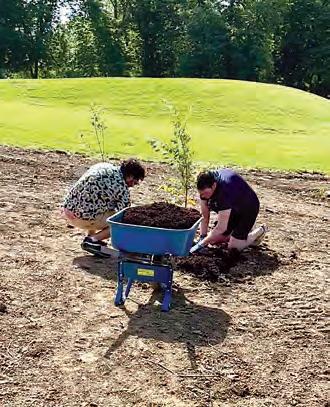
kind of assistance is crucial to their wellbeing.
“Street trees are not like forest trees in the sense that their lives are more strenuous. They have salt in their water during winter, car doors opening into them,” said Crouth of SHUC’s Tree Committee. “They have a much harder life than forest trees,
so they require care. That’s why we go in.”
It’s not just the trees that benefit. For Crouth, his work with the Tree Committee has brought him two primary benefits. One is the human connection sparked when people come together in support of the neighborhood’s trees. The second is how people then are connected with the natural world.
“These trees are huge living beings, even when we plant them as root ball trees, which are already pretty big,” said Crouth. “It’s a spiritual experience when we plant these trees—you can really feel their vitality.”

The Tree Committee welcomes volunteers who want to help maintain and grow Squirrel Hill’s street trees. If you can participate, email info@shuc. org or call 412-422-7666.
Have you ever looked out your front window and wished you were looking at a tree? SHUC’s Tree Committee can help with that!
The Tree Committee consolidates requests from individual property owners who want to add street trees where their property meets the public right-of-way as part of its request for trees from TreeVitalize.
If you want to add your property to the growing list of tree-friendly parcels in Squirrel Hill, scan this QR code or visit shuc.org/projects/trees/ and download the one-page Tree Request Form.

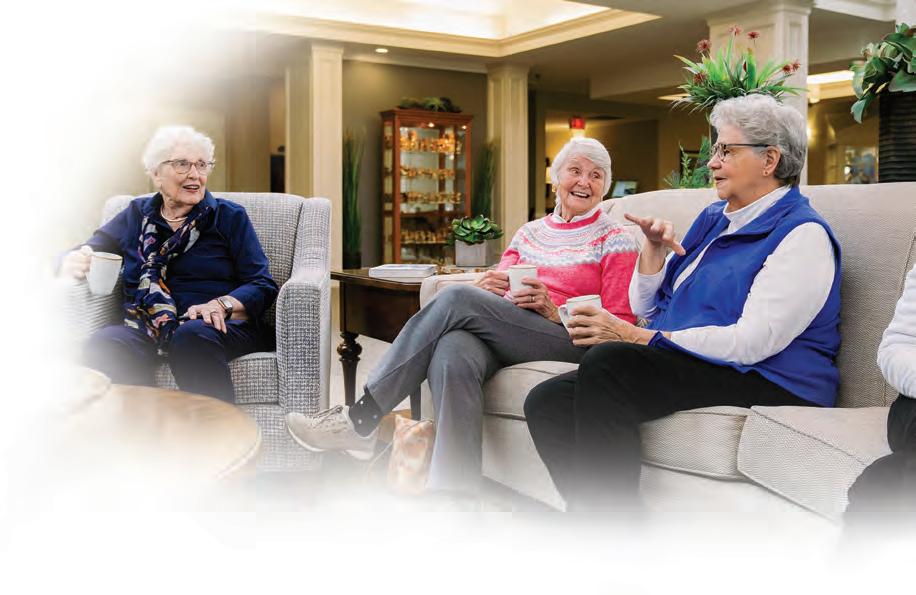




SUMMER IS FINALLY HERE, AND WE HOPE THAT YOU ARE ENJOYING
OUR LOCAL PARKS, places for respite, pickleball, basketball, tennis, baseball, hiking, or whatever is most enjoyable for you. The Coalition was recently awarded a Neighborhood Initiates Fund grant from the Urban Redevelopment Authority for more planters and benches to be installed in the business district, which will make our corridor even more welcoming to our neighbors and visitors.
Behind the scenes we have so much that we do to keep the neighborhood vibrant. Our SHUC Board, Uncover Squirrel Hill, the JCC, merchants, Councilmembers, partnering organizations, local police, security, our city, volunteers, neighbors, and visitors all help to keep Squirrel Hill thriving. It truly takes a village to keep things running smoothly!
Our Bike-Pedestrian and Litter Patrol committees have worked hard behind the scenes to help establish good trail connectivity and calmer, cleaner streets for Squirrel Hill and our neighboring communities of Hazelwood and Greenfield. They are heavily involved in ensuring that important neighborhood projects like the Fern Hollow Bridge and street changes are carried out with the utmost concern for safety.
Our community is very fortunate to have the best in security. Shawn Brokos, Erin Fagan, the JCC, and our local FBI are so dialed in that we very rarely see security risks. When we face a security compromise, their team and our incredible local Zone 4 police force are on the scene immediately.
Our community focuses on mental health support and healing. The JCC offers programs through the 10.27 Healing Partnership, the Center for Loving Kindness UPstanders, and AgeWell to foster healing and mental wellness. The JFCS UpStreet program offers therapy to struggling teens with drop in and virtual services. The Branch and Friendship Circle work with adults of many abilities to create a community of comfort and connectivity.
As we see more isolation and discord nationally, SHUC is working hard locally to bring our community closer together, with Board Members Marshall Hershberg and Vida Passero heading up the effort. The Coalition along with partnering organizations including Phipps and the JCC are in talks with the Blue Zones organization for a potential Blue Zones Activate project in Squirrel Hill and eventually our surrounding communities. Blue Zones are areas where community members live longer—in many cases to 100—with good quality of life. Neighbors and families are well connected, fostering an environment of inclusion. We could not be more thankful for our partnerships with the JCC and Phipps, who both demonstrate the utmost commitment to community care when they develop programs and think about new initiatives.
You might have noticed that it takes the support of several groups working together and collaborating behind the scenes to sustain the good things already happening in Squirrel Hill and bring positive changes to our community. They collaborate to ensure a safe, vibrant Squirrel Hill and partner with other local neighborhoods to help create synergies that support our schools, families, fun events and safe streets. We are proud of our partnerships and thankful to everyone who makes it happen!
Please reach out to share what you would like the Squirrel Hill Urban Coalition to continue, feedback about changes that you would like to see in our Squirrel Hill community, and your thoughts and ideas to help support
us in preserving, improving, and celebrating the quality of life in our vibrant Squirrel Hill community. Volunteers are always welcome and appreciated! You can connect with me at mcohen@shuc.org.
SHUC’s spring started fresh with our annual Clean Sweep Week in late April, organized by the Litter Patrol and its leader, Rachel Lecrone. Hundreds of neighbors and community volunteers walked the streets of Squirrel Hill to pick up litter throughout the week, including on a chilly Sunday morning.

Prizes were awarded to individuals, families, and merchant groups in categories like “Weirdest Garbage” and “Best Photos.” Bagel Factory, Amazing Books and Records, Chocolate Moose, Little’s Shoes, and Games Unlimited provided prizes, and Starbucks on Shady and Representative Dan Frankel contributed food for volunteers. We’re so happy to have their support.
Special thanks to our Zone 4 police, Officer Victoria Butch and police dog Zane, McGruff, Allegheny County Controller Corey O’Connor, and City Councilmember Barb Warwick for stopping by and to Pittsburgh DPW for pick up after the event!
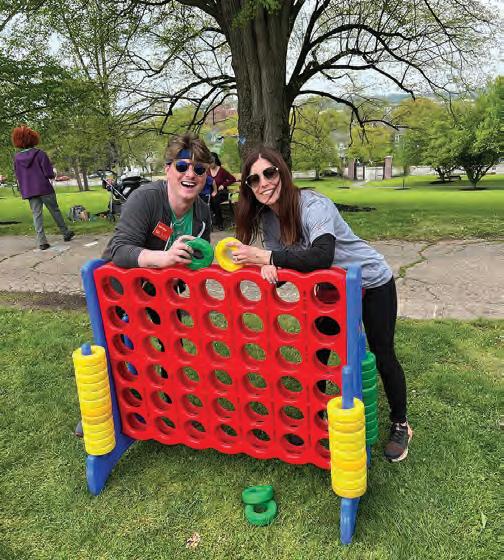
Arbor Day followed shortly after Clean Sweep Week. Friends of Mellon Park brought together nature enthusiasts, tree specialists, and all lovers of outdoor fun for a fabulous, family-friendly event. SHUC’s own Murray the Squirrel stopped by to greet kids crafting at our table, as well as their grown-ups.
In May, we hit the streets for an entirely different reason: to celebrate moms! This year’s Mother’s Day Wine Walk, sponsored by Uncover Squirrel Hill, was a great success. As usual, SHUC set up a table at The Refillery. We’re always thankful that Larissa Russo and her mom invite us to share the space.
All of these events are beloved Squirrel Hill traditions, but SHUC was also lucky enough to be a partner in a special event this spring. On April 21, Gong Universe took place at the JCC. This performance featured Mike Tamburo playing dozens of gongs, bells, and other metal instruments. The event was designed to welcome individuals with autism but was enjoyed by all. The

event’s sponsors were the 10.27 Healing Partnership, led by Executive Director Maggie Feinstein, and Autism Pittsburgh’s Azure Family Concert series, led by Artistic Director Monique Mead. It was such a special experience.
Later this summer and into fall, look for SHUC at the remaining Night Markets on August 31 and September 28. These events feature food and craft vendors, live entertainment, and (fingers crossed for the weather!) a pleasant evening stroll down a pedestrianized Murray Avenue. SHUC will be setting up a table where you can learn more about what we do, sign up to be a volunteer, or just say hello.
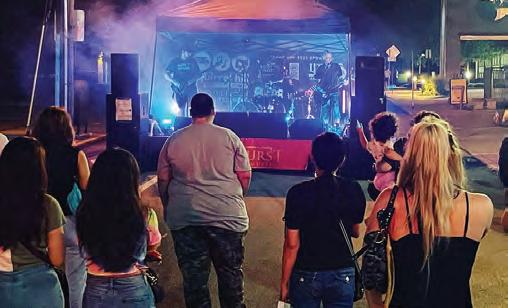
We’ll do the same on certain Sundays at the Farmer’s Market in the parking lot just off Murray between Bartlett and Beacon Streets, all the way into November. Even if you miss us, you won’t miss the fresh fruits, veggies, bread, pies, and other tasty bites available at the other stalls.
There’s nothing like a sunny summer day to make us appreciate the green spaces in our neighborhood. In Squirrel Hill, we’ve got a lot of people to thank for contributing to our community’s natural beauty.
SHUC Board Member Rachel Lecrone recruited Joe Pinkey, Land Surveyor/Field Service Technician from CSD Engineers, to provide mapped locations to DOMI for the requested placement of the benches and planters that will be installed in our business district; the benches and planters are being purchased with a URA Grant. We are so appreciative of Joe’s professional drawings, which will also be used by the Public Works Construction Division to install the benches and planters. SHUC sends a huge thank you to Joe.
Michael Rosenbaum has been tending the garden on the triangular spit of land where the on-ramps to the Parkway East diverge for several years now. We’re so grateful for his time and energy!
At the Neill Log House, it may take a little longer to see the garden fully grown, but many people have helped plant its seeds. SHUC is thankful for everyone involved. Frank Dawson worked pro bono as the landscape architect for the entire site. Tree Pittsburgh donated the fruiting trees and berry bushes that were planted. First Tee – Pittsburgh, the log house’s Schenley Park neighbor, laid the groundwork for us to get a water source to the log house garden.
Actually, after Eric Amato (First Tee’s CEO) and Paul Coultas (its Director of Programs and Instruction) gave their blessing, Phil Mattich used a metal detector to find a potential pipe and then, with Hunter Marshall, dug many feet to uncover a long-buried valve. We followed up with a plumber who set up a system to provide water in the long term. Thank you, First Tee—a terrific program to help youth grow in positive ways through the fun of learning golf.
The Squirrel Hill Urban Coalition is pleased to announce the
Maggie Feinstein Executive Director of the 10.27 Healing Partnership
Rev. Natalie Hall Rector of Church of the Redeemer
Dr. Stanley M. Marks Chairman of UPMC Hillman Cancer Center
Neill Log House Squirrel Hill’s oldest structure

Please join us in celebrating our community’s Treasures at the annual Squirrel Hill Treasures Dinner on Thursday, November 7, 2024 from 6 to 8 pm at The Pittsburgh Golf Club.
For dinner tickets or sponsorship opportunities, visit our website shuc.org, email info@shuc.org, or call us at 412-422-7666.

On Friday, May 10, 2024, St. Edmund’s Academy kicked off their third annual Wolfpack Weekend, celebrating the SEA community with four events spread over two days throughout Squirrel Hill. To start the weekend, SEA students welcomed grandparents, special aunts and uncles, neighbors, and friends to Grandfriends Day, a day celebrating anyone who makes life a little more special for each student. Over 300 Grandfriends joined their SEA student on campus for the morning, and then many departed early for lunch in Squirrel Hill.
Friday afternoon was Grad Bash, where SEA’s recent alumni visited with teachers and each other on the SEA St. Lucy Field, located off Forbes Avenue. Friday evening was a chance for the adults to spend some time together at SEA’s Great Event! Over 200 parents,


faculty and staff, and friends of SEA gathered in the Forbes Avenue parking lot for a party in the heart of Squirrel Hill, with local food trucks, signature cocktails, and a few short blasts of rain.
On Saturday morning, runners of all ages met at Schenley Park for the Wolfpack 3+1 mile run. Congratulations to Scott Stiteler who won the 3-mile race, and SEA 3rd grader Breuer B. who won the 1-mile race.
The 12th annual Allderdice Dragon Run took place Memorial Day weekend at Schenley Park. It was another fun-filled, successful event for students, staff members, and families to raise money for the Dice Cross Country team. More than 150 racers from 4 to 71 years of age finished either a 5K route or a 1-mile path around the Schenley Oval. Students, families, teachers, and staff look forward to another wonderful event next year!
Community Day School recently celebrated a momentous occasion with the planting of a special sapling from the Anne Frank Center USA. This sapling, a symbol of hope and resilience, was dedicated in memory of Holocaust survivors Moshe and Malka Baran, parents of CDS Head of School, Avi Baran Munro. The event coincided with Yom Hashoah, Holocaust Remembrance Day. Eighth graders led the ceremony, offering context through stories of their own family members who were victims of the Holocaust, and highlighting the school’s commitment to Holocaust remembrance and education.

Students, faculty, and community members gathered in observance of Holocaust Remembrance Day and to witness the dedication of this living tribute. The sapling originates from the chestnut tree that Anne Frank often gazed upon while in hiding, a symbol that provided her with solace and a connection to the outside world during her most challenging times. This particular sapling represents not only a connection to the past but also a beacon of hope for future generations at CDS.
Ruth and Scott Apter, Co-Chairs of the CDS Grandparent Association, played a pivotal role in bringing this meaningful project to fruition. Their dedication and hard work ensured that the sapling found its new home at Community Day School. The Apters’ involvement underscores the vital role of the broader school community in supporting and enhancing the school’s mission. Their efforts in navigating the logistics necessary to secure the sapling for CDS were instrumental along with Lauren Bairnsfather, CEO of Anne Frank Center USA.
During the ceremony, Avi Baran Munro expressed deep gratitude for the honor bestowed upon her
parents, acknowledging the profound significance of the sapling and its message of hope and perseverance through the darkest of times. It is a living memorial that will inspire and educate generations of students for years to come.


CDS inspires our students with learning that is joyful, engaging, experiential, and enduring.
Visit comday.org to schedule your tour of Pittsburgh's independent Jewish day school.
By Pavel A. Marin

Pavel A. Marin is a 2024 graduate of Pittsburgh Allderdice High School who has served as a member of the Superintendent’s Student Advisory Council, the Pittsburgh Promise Ambassador program, and the Allderdice student newspaper, The Foreword. Marin was also Class President during the 2021-2022 school year. He will attend Pennsylvania State University this fall, majoring in political science.
IF OUR COMMUNITIES’ DECISION-MAKING BODIES WANT TO LEARN ANYTHING ABOUT IMPROVEMENT, ASK A YOUNG PERSON. A part of my work, day in and day out, is ensuring that systems are in place to involve youth and considerately gather their viewpoints to make improvements in our lives. While I have now graduated and departed high school leadership, I spent a lot of time during high school working to make sure that governing systems in this region have accessible student leadership that can advise them and make those crucial improvement calls.
My high school experience was certainly unique, given the COVID-19 pandemic interruption to the education system, but it also offered unexpected opportunities. At least, that’s what I got from it. Being pushed into a high school building as a sophomore after spending a year online was not the most desirable option. Yet it is one that I believe led me to greatly mature, having been elected as the head of class and later holding numerous leadership positions where I brought real change to a school that needed it. My school, Taylor Allderdice High School, famous for its academic record, highly populated and diverse student body, and its promising leaders of tomorrow, was in need of an image boost. One of my biggest priorities was to show the region why people should aspire, once again, to the dreams and hopes of a well-rounded public education system.
Pittsburgh Public Schools needs its students to help beyond the level of the individual school, and that’s why I wanted to help the district. In June 2022, at the end of my sophomore year as Class President, I was elected to serve as an Allderdice member of the Superintendent’s Student Advisory Council. Joining that group of student leaders from all the PPS high schools opened my mind to how different every school was.
Passionate about understanding the priorities of a new superintendent, Dr. Wayne Walters inspired me to advocate. Walters’ calling for student voices to be at the table truly made me more inclined to speak up and speak out. I was fed up with the issues in my building never being discussed and the discouraging comments I would hear from staff members and administrators, but this only energized me more to start leading where it was necessary.
Overall, I tenured two productive years as a member of the Student Advisory Council in which I developed student-programmed proposals that were paid for via the federal government’s ESSER funding. These efforts provide for mental health and social emotional learning supports, field trips, academic programming, and classroom tools. The truth is that working as a student
to spend federal dollars is no easy task. If you want student voice to be a sustainable factor in decisionmaking, you need everyone in your organization to be on board.
In recent months, I’ve been petitioning the Pittsburgh Public Schools’ Board of Directors to establish a student board representative role to ensure student voice can reach that decision-making body. The critical decision-makers in the Pittsburgh schools have an

opportunity to prioritize listening to student voices. Alongside this school board matter, I have been working with Pittsburgh City Council staff to create a youth council that works to address issues of importance to young people in this city.
In my senior year, I also served as an Ambassador for the Pittsburgh Promise where I’ve engaged students in the college process and have actively promoted this incredible scholarship program. My time with the Pittsburgh Promise has been a great tool for networking, leadership, and programming. In addition, my service with the World Affairs Council of Pittsburgh has driven me to passionately advocate for an inclusive and globally-minded region. Working to educate professionals including teachers, academic and business leaders, community members, and young people through professional learning opportunities has grown me into a leader. I can look upon my accomplishments and stand proud.


The author discusses summary citation procedures with one of Allderdice’s police officers.
These experiences shaped me and my commitment to the core work of the youth voice. Give young people space to grow as leaders and let them make mistakes. Theirs is an unentrenched perspective. You give the future a better shot when you give youth that solemn chance to lead. We can all learn from each other that incorporating youth into decision-making and community leadership is no bad bet.

membership
GET TO KNOW— AND APPRECIATE— YOUR
By Lawrence Gerson, VMD

BEHIND THE DOORS OF EVERY VETERINARY FACILITY ARE THE NURSES AND RECEPTIONISTS THAT MAKE THE OFFICE RUN EFFICIENTLY. They are the true rock stars of the profession. These staff members are the pet’s best advocates, always looking to provide pain relief when needed, compassionate handling, and loving kindness. Get to know these technicians by name because they make a big difference in your pet’s health.

A Licensed Veterinary Technician, also called a CVT, or Certified Veterinary Technician, as defined in the Pennsylvania Veterinary Practice Act, is a staff member that has had formal training for 18 months and passed a national exam. Additionally, continuing education hours are required to keep a license. The Veterinary Assistant does not have a license but may have attended a veterinary technician school that was not accredited at the time. Some assistants may also be trained within the veterinary office and might have years of experience. The Practice Act permits the assistant to perform many of the same functions as the CVT but with more supervision from a veterinarian. When choosing a veterinary office, look to see how many of the nursing staff are licensed. Also consider how many years of experience the staff has. A
growing office will hire new staff, but the core should be experienced technicians.
A CVT functions as you would expect a nurse to help with your own health care. They take your pet’s history, check vitals, draw blood, and run laboratory tests. Technicians start and maintain intravenous fluids, medicate, and treat hospitalized pets. In radiology, they take diagnostic images. Dental care is important for pets, and the technicians will help with anesthesia, intubate patients, and perform the removal of plaque and tartar from the teeth. During surgery the staff will assist the veterinarian and monitor the patient. Without their help in surgery and recovery, a veterinarian would be overwhelmed.
Beyond their role in medical care, veterinary staff members
can provide other services to clients. In today’s world, a busy veterinarian will have a “Call Back List” a mile long to get to in between appointments, during lunchtime, or at the end of the day. Knowledgeable owners will turn to the full veterinary staff to answer questions or help with urgent needs. Likewise, discussing pet products with the technician staff can get you the right products, often with rebates that make them more affordable. Some clients think they are saving money by purchasing pet products online, but purchasing quality products from the veterinary office that are guaranteed by the manufacturers provides support for the veterinary staff that may just one day save your pet’s life.

One of the most difficult positions in the veterinary office is the receptionist, who is often referred to as the Client Service Representative. The receptionist has to differentiate between client calls that are emergencies needing to be seen immediately and those
that are less urgent. Offices can be fully booked on any given day, with the spots reserved for urgent appointments filling early in the day. There is a critical balance between getting pets seen when needed and overwhelming a busy staff, and the receptionist is essential to maintaining that balance.
Working in a veterinary hospital is more than playing with puppies and kittens all day. Days can be long and difficult, and clients can be demanding. The stress can be hard to deal with. Clients understanding how difficult working at a veterinary office can be would go a long way in helping a busy staff provide the best possible care for pets.






By Helen Wilson, Vice President, Squirrel Hill Historical Society
IT GOES WITHOUT SAYING THAT SQUIRREL HILL WAS NOT ALWAYS THE WAY IT IS TODAY. THE NEIGHBORHOOD EXPERIENCED MANY CHANGES THROUGH TIME. One way to learn about these changes and trace their impact in the present is to follow past events in real time, as they happened, through newspapers. Although major city newspapers rarely covered minor, day-to-day occurrences in local communities, small neighborhood newspapers in and around Pittsburgh filled the void—at least until the internet came along, causing most community newspapers to go out of business.
Concurrently, the internet has been a boon to old newspapers. If (and a big IF ) copies of old newspapers still exist, they can be digitized and put online, making searching them through keywords much easier than spending endless hours rummaging through old microfiche reels at the library.
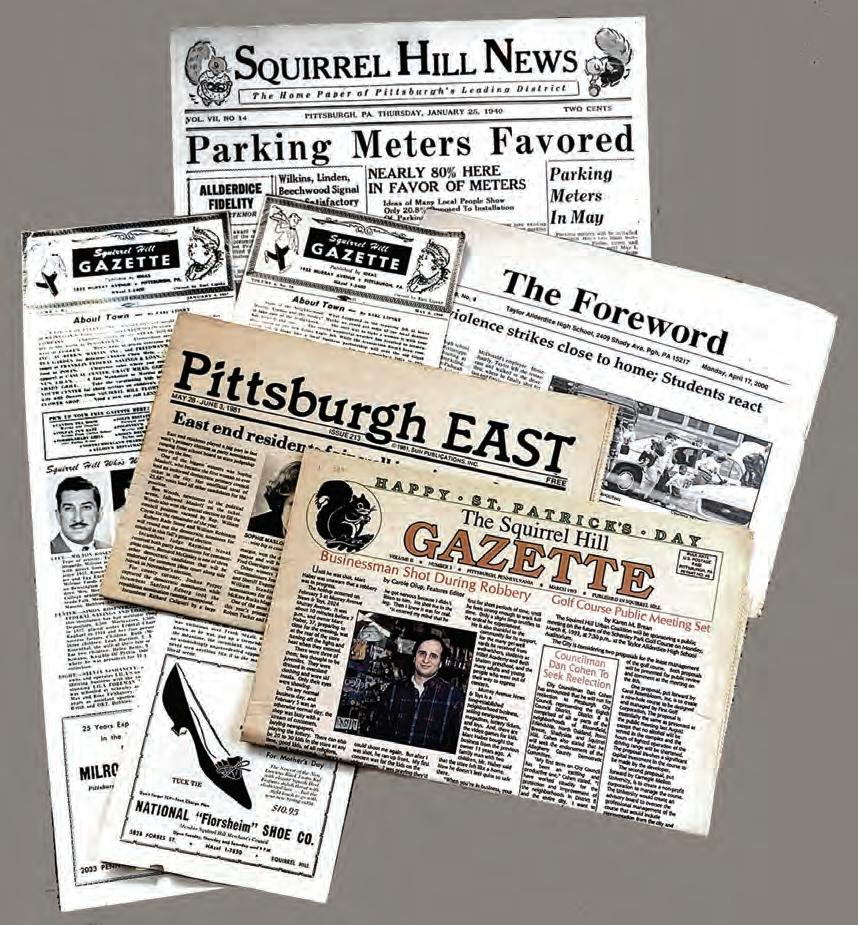
Squirrel Hill had several newspapers through the years. The most well-known is the Squirrel Hill News, published weekly from 1929 into the 1970s. The Squirrel Hill Historical Society (SHHS) is fortunate to have received a donation of bound copies of most of the newspapers from 1935 to 1970 a while back and an additional gift
of some missing issues from 1964 a few years ago. The issues were digitized by the Carnegie Library and put online by the University of Pittsburgh/Archives Service Center. They can be accessed at historicpittsburgh.org and the SHHS’s website, squirrelhillhistory.org.
Unfortunately, the SHHS doesn’t have any Squirrel Hill News issues from 1929 to 1934, and any issues from those years in the newspaper’s own archives no longer exist due to a fire that destroyed its offices in 1956. The newspaper also published issues after 1970, but the SHHS has no copies of them either, except for a single issue from 1973.
We read about it in a newspaper, of course!
So, how do we know about the fire at the Squirrel Hill News offices and the missing issues of the newspaper?
We read about it in a newspaper, of course! Since the fire at the Squirrel Hill News offices was major, the event was reported in The Pittsburgh Press on January 17, 1956. The front-page headline proclaimed, “Fire Hits Block in Squirrel Hill.” Probably the pun was intended— it was the Block Building that held the offices. The building was located at 1909 Murray Avenue at the corner of Murray and Bartlett Street, later replaced by the Giant Eagle.
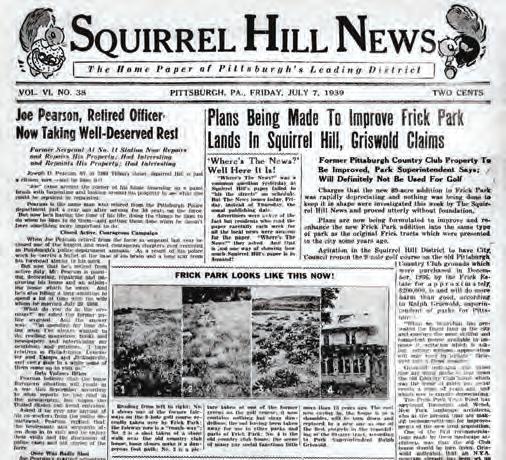
The Squirrel Hill News reported on a wide variety of serious local issues and events. Perusing sequential issues allows a reader to follow the thread of a story as it develops. An example is the changes in Frick Park at the sweeping lawns along Riverview Trail beyond the Blue Slide Playground. The story starts in 1939, when this area, which once housed the Pittsburgh Country

Landscape Design
Plant and Shrub Installation
Lawn Mowing
Lawn Maintenance
New Lawns
Reseeding
Spring and Fall Cleanups
Mulching
Retaining Walls
Pavers
Patio Design and Installation
Sidewalks
Walkways
Paver Driveways
Pond Installations
Storm Cleanups
Snow Removal
French Drains
Land Clearing
Power Washing
Overseeding

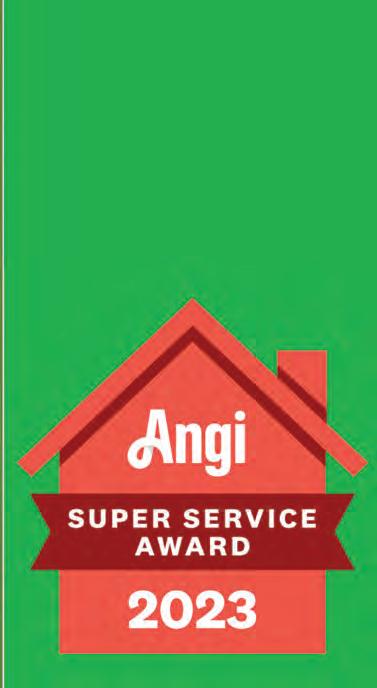
Club, was purchased as an 89-acre addition to the park. By 1939, the land was reportedly in poor condition, leading the Squirrel Hill News to investigate.
The headline on the front page of the July 7, 1939, issue reads, “Plans Being Made To Improve Frick Park Lands In Squirrel Hill, Griswold Claims.” The accompanying set of four photos—emphatically labeled “Frick Park Looks Like This Now!—shows the sorry state of the former clubhouse and grounds. The roof of the clubhouse had fallen in, and the sod on the golf course had been removed. In the article, Park Superintendent Ralph Griswold says plans for the land call for “the same type of park as the original Frick tracts which were presented to the city some years ago.”

The clubhouse was eventually torn down, but its remains and the detritus from other demolitions in the city were dumped over the hillside below it. Knowing that the area had been a city dump, present-day hikers and bicyclists on Upper and Lower Concrete Block Trails can understand why concrete blocks, bricks, and other debris line both sides of the trails. Likewise, vestiges of the golf course’s putting greens can still be seen on the grassy fields. During the Cold War, those same fields became an anti-aircraft site with Nike missiles and GIs stationed in tents. When the missile site was moved, the city debated putting the State Police headquarters there; Washington Boulevard was chosen instead.

Old newspapers are a treasure trove for researchers, genealogists, and local history enthusiasts, especially now that they can be digitized and put online. But to do that, we need to have the original paper issues. The Squirrel Hill Historical Society is asking anyone who has copies of Squirrel Hill News
Squirrel Hill Gazette
The Foreword (of Allderdice) Pittsburgh East
to contact us through our website, squirrelhillhistory.org, or email us at sqhillhist@shhsoc.org. We will scan them and return them to you.


Another newspaper published in Squirrel Hill was the oddly shaped Squirrel Hill Gazette. It was originally printed on two sheets of glossy white paper folded to 6 in. x 17 in. The SHHS has only two of those issues—January 1, 1957, and May 4, 1960—and a third from March 1993, after the newspaper switched to a more usual newspaper format similar to the Squirrel Hill News. The Gazette issues were donated by people who had reason to keep them. The first two mentioned a reader’s daughter, and the 1993 issue was given to the SHHS by the “Businessman Shot During Robbery,” as the headline reads. That businessman was Marc Haber, owner of Murray Avenue News & Toys, who was the victim of a robbery gone violent. He had kept the newspaper as a reminder of that frightening incident.
… folksy, stream-ofconsciousness ramblings on all things
The older issues of the Squirrel Hill Gazette were folksy, stream-of-consciousness ramblings on all things Squirrel Hill. They start at the top with “About Town – by Earl Lipsky.” The opening lines of the January 4, 1957, issue read, “A LITTLE of EVERYTHING.— Corned beef and potato pancake sandwiches at WEINSTEIN’s. Reductions on men’s FLORSHEIM shoes at NATIONAL SHOE COMPANY. … Champion steaks at the STEAK HOUSE. … Best delicatessen in the world at POLONSKY’S. … Tremendous savings on women’s footwear at LORRES’S. … To the CANTON TEA GARDEN for delicious Chicken Chow Mein. … Out of this world food at POLI’S. … A fast Manhattan or Martini pick-me-up at the FORBES-SHADY GRILL. …” and on and on, interspersed with ads from local businesses. One section was entitled “Squirrel Hill Who’s Who,” featuring short bios of store owners and other notables of the community.

Squirrel Hill’s Taylor Allderdice High School (now Pittsburgh Allderdice) had a long-running and very professional-looking student newspaper, The Foreword. It has now moved to an online format. The SHHS has only six issues from 1998–2000, which I saved when my sons attended the high school. Another newspaper, Pittsburgh East, which catered to residents of the East End, began publication in 1974. The only issue the SHHS has is dated June 3, 1981, and features a picture of Sophie Masloff, who “wins big in council race.”
Today, Ann Belser is trying to keep local journalism alive by producing Print: Pittsburgh’s East End Newspaper Future historians will be grateful.

Anyone interested in learning more about Squirrel Hill history is invited to attend the programs of the Squirrel Hill Historical Society, held on the second Tuesday of each month at 7:30 p.m. at the Church of the Redeemer, 5700 Forbes Ave. The programs are also on Zoom. Go to www.squirrelhillhistory.org to request a link to the Zoom program and for updates and announcements of upcoming lectures and events. Please consider joining the SHHS. Membership is only $15 per year ($25 for families). There is no charge for attending the meetings.
TUESDAY, AUGUST 13
(Tentative) Members’ Social
TUESDAY, SEPTEMBER 10
“Jewish Family & Community Services, Present & Past”
IVONNE SMITH-TAPIA, Director of Refugee and Immigrant Services at Jewish Family and Community Services (JFCS), will explain how the organization helps immigrants and refugees build new lives in Pittsburgh and provide an overview of the organization’s 80-year history.
TUESDAY, OCTOBER 8
“The Story of Dragon’s Den”
GUILIA LOZZA PETRUCCI, executive director of Dragon’s Den, a non-profit organization housed in the former St. Mary Magdalene Church on Amity Street in Homestead, will discuss the history of the building and how Dragon’s Den’s innovative programs teach youth from diverse backgrounds and abilities to overcome challenges in themselves, their communities, and the world.
TUESDAY, NOVEMBER 12
“Writing the First Draft of History” (Rescheduled from April)
ANN BELSER, publisher and writer of Print, the East End Newspaper, will tell the story of how Print came to be, some of the stories behind the stories that have been published, and what it is like running a local newspaper where the people you cover are also your neighbors. She will also talk about some of the Squirrel Hill businesses that Jan Kurth has written about for the newspaper.


